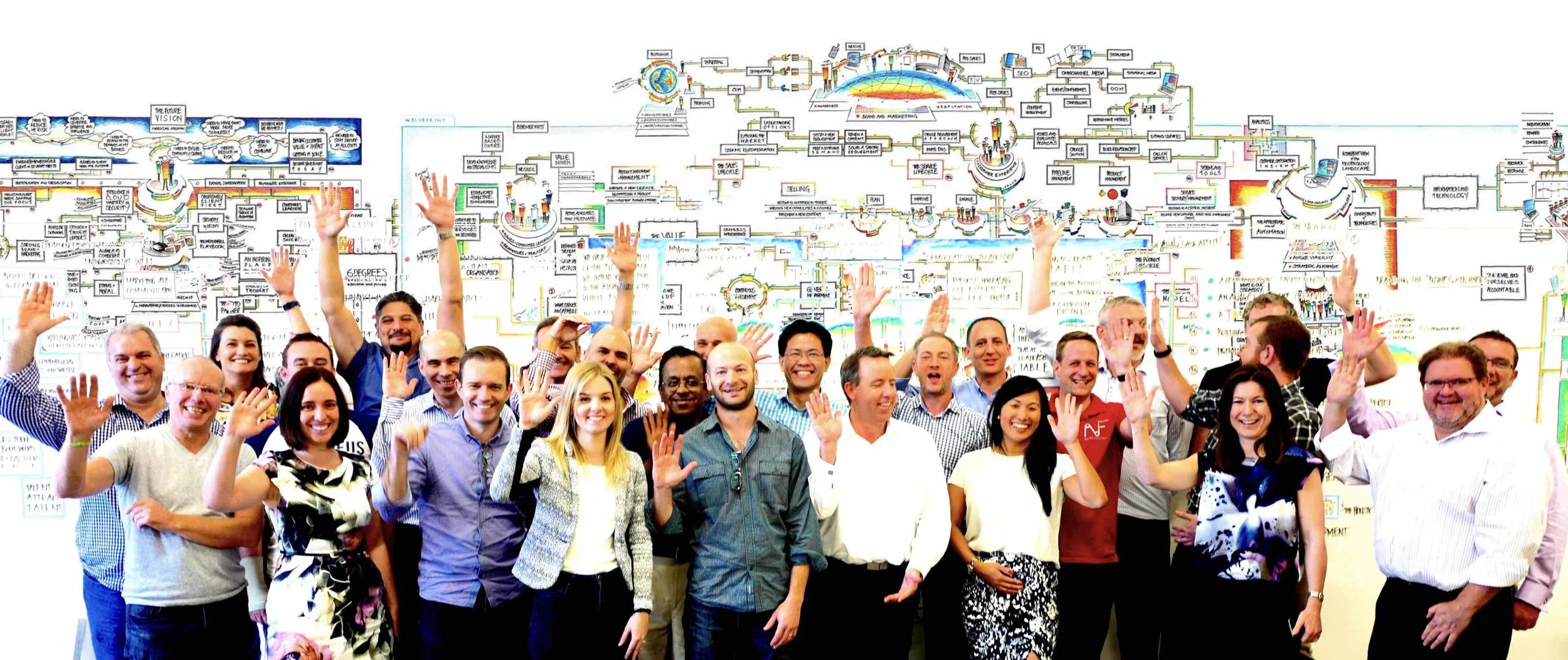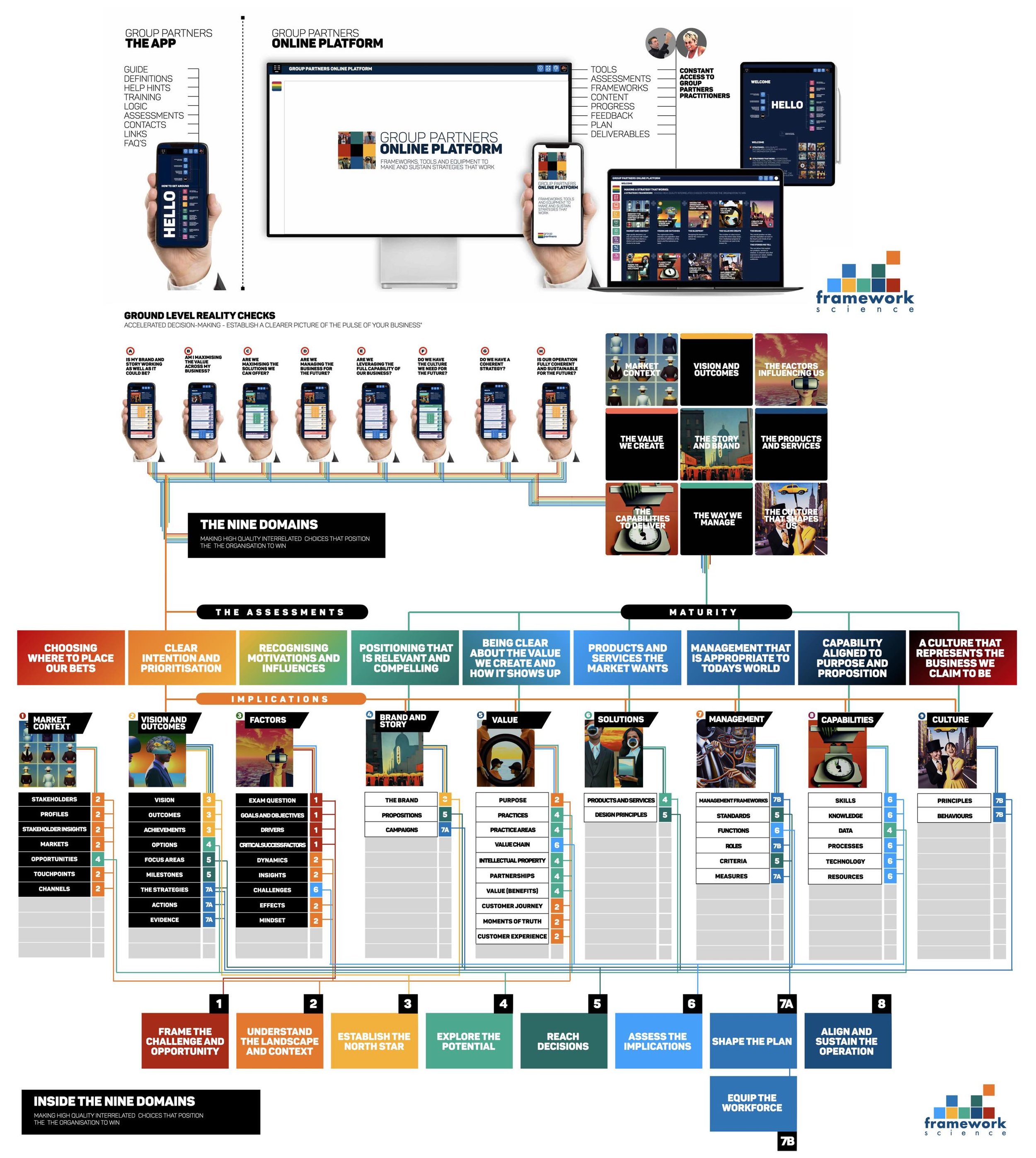
THE QUESTION:
How does Structured Visual Thinking™ impact learning and how can students study and professors teach better with SVT?
Jay
When I was a kid starting out in business, I worked for a technology business. This was before anyone had a concept of what a technology business was. My friends said you’re creative; come and work with us. So I did.
Unstructured Meetings
I entered the world of business with few if any, tools under my belt. So I looked around and realised no tools existed to help me understand, collaborate and think with my peers.
We just went into rooms and talked at each other.
Very little was learned because everything was unstructured. Information flew between people with vastly different maturity levels and interests in critical discussions.
Nobody could wrangle it to the ground. We started every meeting as if everything was new, even though much of it had been spoken of before. It was impossible and highly frustrating.
Structured Visual Thinking™ - The most powerful way for individuals and teams to learn
Conversations are the raw material of human progress. Words are the currency, and the result of using them well is our economy of thought and ideas.
Fast forward to how we communicate today and enter ‘text’ as the universal interface. Prompts, language models, and reinforcement strategies that humans must master to use these immensely powerful new tools.
My insight throughout this journey was the importance of visualisation, particularly the live engagement of others within it.
Magic happens when people see their ideas realised. Put structure and logic to it, and even more magic happens. The value of their idea takes its place alongside others, and the vital context of everything is appreciated. Magic and logic combine, and people revisit their logic based on the new magic.
I invented Structured Visual Thinking™ - a way of individuals cooperating in teams and each learning very quickly from the other and making progress.
In many ways, it’s very simple. To accelerate learning, break the topic into meaningful categories and systematically visualise the information so everyone understands, engages and thinks more critically to improve.
Improvement is important because there will be gaps and opportunities. The team will spot this immediately and realise (for the first time) the risk and the value of evolving the learning.
Visual learning and co-created visualisations (at the core of Structured Visual Thinking™) are effective because they leverage the brain's natural preference for visual processing. The approach reduces cognitive load, increases engagement, promotes social interaction, and enhances problem-solving and critical-thinking capabilities. These factors combine to create a more meaningful and memorable learning experience.
I’ve added below the features of Structured Visual Thinking™—the direct application of it within the learning and teaching sphere.
Structured Visual Thinking™ - The easiest way to arrive at the right results
The Power of Structured Visual Thinking™ for Enhanced Learning and Teaching
Structured Visual Thinking™ can significantly enhance student engagement and motivation by providing a dynamic, interactive, visually appealing learning approach.
By incorporating visual tools and techniques that encourage active participation and collaboration, Structured Visual Thinking™ creates an environment where students can thrive.
We can create topic-based and themed visual frameworks built on curricula. They are embedded with storytelling and rich data or stimulus built into the classroom or online teaching and learning process.
Structured Visual Thinking™ - Clarity and guidance to individuals and teams
Structured Visual Thinking™ (SVT™) For Students:
Catering to Different Learning Styles—SVT™ accommodates various learning styles by presenting information visually. Working visually helps auditory, visual, and kinesthetic learners engage with the material more effectively. It ensures all students can connect with the content, fostering motivation and self-confidence.
Encouraging Active Learning—unlike traditional, passive learning methods, Structured Visual Thinking™ promotes active engagement with the material. Students are encouraged to add ideas or create further visual representations of the foundational frameworks. Because of logic, they can more quickly analyse connections and synthesise information. Consequently, it keeps them more invested in the learning process.
Promoting Collaboration—Structured Visual Thinking™ fosters teamwork by facilitating group exercises and discussions. Working together allows students to share ideas, learn from one another, and build a sense of camaraderie, which can increase motivation and engagement.
Structured Visual Thinking™ - Generating clarity and engagment through powerful visuals
Enhancing Creativity: Using visual tools such as logical frameworks and topic-based rich illustrations and infographic treatments. Structured Visual Thinking™ encourages students to think much more creatively and, through direct prompts, explore alternative perspectives. This creative freedom sparks curiosity, stimulates interest, and drives more motivation.
Making Complex Concepts Accessible: SVT™ deliberately breaks down complex ideas into digestible, visually appealing components, making it easier for students to grasp challenging concepts. As students better understand the material, they are more likely to stay engaged and motivated.
Providing Immediate Feedback: SVT™ provides real-time feedback and adjustments, enabling students to identify gaps in understanding and make corrections quickly. A rapid feedback loop helps students stay engaged as they see their progress and feel a sense of achievement.
Structured Visual Thinking™ - Modules within logical frameworks that explain the story
For Teachers,
Structured Visual Thinking™ is a unique and groundbreaking approach to critical thinking. It harnesses the power of visual collaboration and facilitates conversations to revolutionise the learning process.
Students significantly enhance their studying techniques by introducing proven logical frameworks into classrooms. And professors can elevate their teaching methods.
Structured Visual Thinking™ - Logical, systemic and proven method of understanding complexity and solving complex challenges as individuals and teams.
What is Structured Visual Thinking™?
Structured Visual Thinking™ is a systematic method of organising and synthesising a topic. It transforms complex ideas through visual representations. These logic frameworks explain a given subject's story in discrete modules. Examples are shown here.
Collaborative frameworks encourage active participation, foster creativity, and promote an in-depth understanding of concepts by engaging multiple learning modalities.
Structured Visual Thinking™ - Classroom style or online - visuals make the difference
Transforming Impact Learning:
Structured Visual Thinking™ offers numerous benefits to students and educators in impact learning:
Enhanced Knowledge Retention: By presenting information visually, Structured Visual Thinking™ caters to different learning styles and helps students retain information more effectively. Visual representations facilitate the encoding and retrieval of information in our brains, leading to better recall and understanding.
Improved Critical Thinking: Structured Visual Thinking™ challenges students to analyse, synthesise, and evaluate information as they create visual representations. This active engagement with the material fosters critical thinking skills and promotes deeper understanding.
Increased Collaboration: The collaborative nature of Structured Visual Thinking™ encourages students to work together, share ideas, and build upon each other's perspectives. This teamwork approach enhances learning outcomes and fosters essential communication and interpersonal skills.
Structured Visual Thinking™ - All the frameworks and modules are digitally evolved as required.
Empowering Students and Professors
By incorporating the tools and techniques of Structured Visual Thinking™ into their study and teaching strategies, both students and professors can experience remarkable improvements:
For Students: By using visual tools such as mind maps, flowcharts, and diagrams, students can organise their thoughts. Students and teachers can break down complex concepts and identify connections between ideas. This approach helps students stay engaged with the material, improves memory retention, and promotes a deeper understanding of the subject matter.
For Professors: Professors can leverage Structured Visual Thinking™ to create more engaging lesson plans and facilitate dynamic classroom discussions. By incorporating visual aids and encouraging students to participate in collaborative exercises, educators can foster an environment that nurtures creativity, critical thinking, and effective communication.
Structured Visual Thinking™ - Engagement is everything
Some practical ways to implement Structured Visual Thinking™ in the classroom:
Use Visual Aids: Enhance lectures and presentations with visual frameworks and infographics within logical stories to better convey complex concepts and relationships. Visualisation helps students contextualise information, making it easier to understand and remember what’s been learned.
Assign Collaborative Activities—Encourage students to work together on group projects that involve creating visual representations of concepts or solving problems using visual thinking tools. These activities promote teamwork, communication, and critical thinking while reinforcing the subject matter.
Integrate Visual Note-taking—Encourage students to take notes using visual techniques such as sketching to augment existing visual modules and create concept diagrams. This approach helps students actively engage with the material, organise their thoughts, and identify connections between ideas.
Facilitate Classroom Discussions—Use visual thinking tools to guide classroom discussions and debates. For example, create a visual representation of differing viewpoints on an issue or use a flowchart to map out the progression of a conversation. This method encourages students to think critically and express their ideas visually.
Structured Visual Thinking™ - Designed for the style of learning fit for our age
Incorporate Visual Problem-solving—Teach students problem-solving techniques using visual thinking tools. For example, breaking down complex problems into smaller, manageable pieces using frameworks and modular logic and breaking the topic into its constituent parts to illustrate the cause-and-effect relationships between different factors.
Implement Visual Assessments—Design assessments that require students to use visual thinking skills to create their own concept frameworks, modules and/or infographics. Such approaches test their understanding of the material and assess their ability to synthesise information and think critically.
Provide Visual Feedback—Offer feedback on students' work using visual formats, such as annotating their visual representations or creating a diagram to illustrate improvement areas. Visual feedback helps students better understand their strengths and weaknesses while reinforcing their visual thinking skills.
Create a Visual Learning Environment—Encourage a visually rich learning environment by displaying student work, creating visual resources, and providing access to visual thinking tools. This fosters a culture of visual thinking and creativity in the classroom.
Structured Visual Thinking™ - It’s never too early to start thinking visually.
Why visuals and visualisation aid learning, retention and application:
Visuals and visualisation tap into our innate mental capabilities, promote deep learning and lead to highly accessible memories. Easy-to-access memories are why they accelerate and enhance learning, retention and application.
Visual information is more memorable. Our brains are highly visual, and we have strong visual-spatial memory. Visuals tap into this powerful mental faculty and give us mental hooks to hang our learning on. Creating a visual makes the information much more retrievable later.
Visuals simplify and illustrate abstract concepts. They translate complex ideas into a simple visual form that is easier to understand, remember and apply. Things like diagrams, illustrations and metaphors all tap into our visual-spatial reasoning ability.
Visualisation is an active mental process. When we visualise information, we engage our mind's eye to manipulate, process and integrate the information. This active cognitive processing embeds learning much more deeply than just the passive reception of information.
Co-creating visuals provide even more benefits. When we actively work to construct a visual representation of information, we gain an even deeper understanding. We must think about the most effective way to represent the ideas visually; this reflection and mental manipulation help consolidate our learning. It also gives us a sense of ownership over the material.
Visuals facilitate connections and ‘big picture’ understanding. Visual information and visualisation help us to see relationships between ideas. This information helps students gain a broad topic overview and integrate each discrete fact into a connected conceptual framework. This holistic understanding sticks with us much more than superficial or compartmentalised knowledge.
We can access visual memories faster. Visual information has a high degree of ‘availability’ - it springs to mind rapidly when we need to apply our learning. This is because visual-spatial memories have a strong associative quality, and the information is well integrated so we can navigate it quickly.
Visuals and visualisation help us learn, retain, and use information faster and more meaningfully for several reasons. Firstly, the human brain is wired to process visual information more efficiently than text or speech. The brain can process visual information 60,000 times faster than text, and 90% of the information transmitted to the brain is visual.
Visualisation also helps us to remember information because it creates a mental image that is easier to recall than a string of words. When we see a picture, our brain stores it in our long-term memory, making it easier to retrieve the information in the future. Moreover, when visualisation is co-created, it engages the learner in the learning process, making it more interactive and participatory.
By actively participating in creating the visualisation, learners are more likely to remember and understand the information being presented.
Visualisation also helps to simplify complex information and make it more accessible to learners. Learners can more easily comprehend and preserve information by breaking it into smaller, manageable parts.
Structured Visual Thinking™ - Evolved through many clients and challenges for over two decades
Facts About Structured Visual Thinking™
Visual processing: The human brain processes visual information much faster than text or spoken language. About 50% of the brain is involved in visual processing, and it can interpret visuals in as little as 13 milliseconds. This efficiency means that visuals can be absorbed and understood more quickly than other forms of communication.
Cognitive Load Reduction: Visuals help reduce cognitive load, the mental effort required to process information. By organising information and making it visually appealing and easily understandable, visuals can decrease the cognitive load. This makes it far easier for the brain to remember and recall information later.
Increased Engagement: Visuals are generally more engaging and enjoyable than plain text, which can increase motivation and focus. This heightened engagement can lead to a deeper understanding of the material and improved retention.
Dual-Coding Theory: According to dual-coding theory, the brain processes textual and visual information separately. By presenting information using text and visuals, the brain can create multiple mental representations of the same material, strengthening memory and recall.
Co-Creation Benefits: Co-creating visualisations adds another layer of effectiveness to any learning process. When individuals work together to create visual representations of information, they actively engage in learning, leading to better comprehension and retention. Additionally, co-creation promotes social interaction, which can further enhance learning outcomes.
Personalization and Relevance: Co-created visualisations are tailored to the specific needs, preferences, and perspectives of the individuals involved factored alongside a given curriculum. This personalisation makes the information more relevant and meaningful, increasing the likelihood that it will be remembered and applied.
Problem-solving and Critical Thinking: Co-creating visualisations encourages problem-solving and critical thinking skills. Participants must analyse, synthesise, and evaluate information to create an effective visual representation, which can ultimately lead to a deeper understanding of the material.















